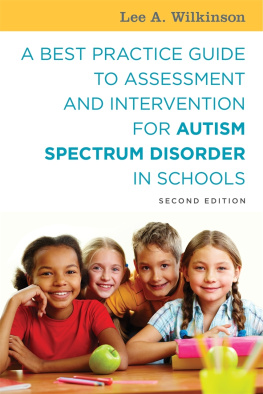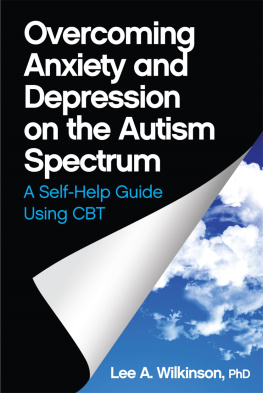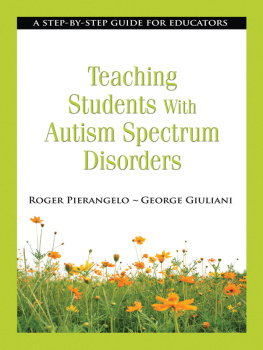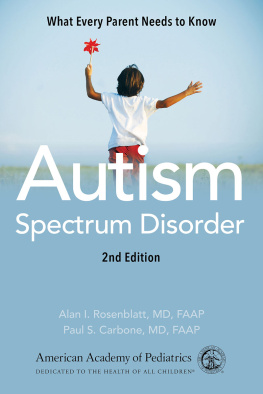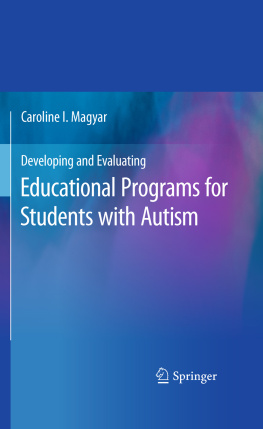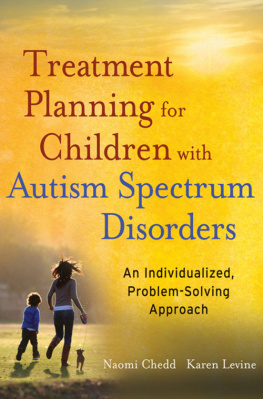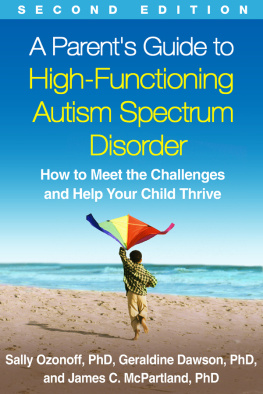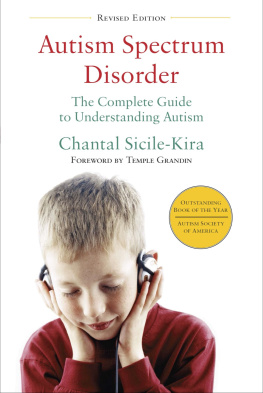
A BEST PRACTICE GUIDE
TO ASSESSMENT AND
INTERVENTION FOR
AUTISM SPECTRUM DISORDER
IN SCHOOLS
SECOND EDITION
Lee A. Wilkinson

Jessica Kingsley Publishers
London and Philadelphia
CONTENTS
PREFACE
Since the first edition of this book was published, the field of autism has expanded dramatically. New and significant developments have taken place in assessment and outcome research, practice guidelines, and treatment reviews. This revised and updated edition reflects the most recent progress in evidence-based assessment and intervention, and outlines the most current relevant and valued information necessary for the competent delivery of services for children and youth with autism spectrum disorder (ASD). The basic objective and perspective of the first edition remains unchanged. The primary aim is to provide school-based professionals with a balance of conceptual, practical, and empirical information designed to bridge the research-to-practice gap in identifying, assessing, and intervening with school-age children on the autism spectrum. Likewise, this edition continues to be guided by the fundamental premise that autistic traits exist along a spectrum of severity with respect to the core symptomatology, age of onset, and need for services.
The challenge to improve the services to children with ASD in our schools centers on the adoption of evidence-based practices in assessment and classroom intervention. An important theme woven throughout this book is the application of best practice guidelines in the assessment and treatment of school-age children and youth with ASD. A best practice may be defined as a technique, strategy, or methodology that, through experience and evidence-based research, has proven to reliably lead to a desired outcome. This requires an understanding of evidence-based research and the integrative process of embedding this knowledge into the school organization and delivery of services. Best practice guidelines are developed using the best available evidence in order to provide school-based professionals with evidence-informed recommendations that support practice and guide practitioner decisions regarding assessment and intervention in the school context. Best practices for school-based practitioners are also best practices for students and their families.
This revision continues to focus on best practice or state-of-the-art approaches to assessment and treatment for ASD. As with the first edition, this Guide provides current information and recommendations that are consistent with scientific research and empirically guided practice, rather than speculation and theory. While this edition retains the same basic structure as the previous one, the chapters have been revised to incorporate current research and developments in the field. This includes updated test information and the addition of new instruments. The list of evidence-based treatments and intervention strategies has also been adjusted to reflect the most recent rigorous scientific outcome reviews. Best practice in special education has been expanded to include evidence-based support strategies, procedures for working with families, and a discussion about special education law and legal issues. These revisions and additions make the text more a comprehensive and practical guide for the school-based professional.
PURPOSE
In order to adequately meet the needs of students with ASD, it is essential that school-based professionals understand the characteristics of this neurodevelopmental disorder, utilize appropriate assessment tools, provide evidence-based recommendations for intervention across the continuum of services, and offer consultation to educational staff and families. T here has been a significant increase in the number of journal articles, book chapters, textbooks, and various publications outlining information regarding educational practices, supports, and procedures that are reportedly effective for students on the autism spectrum. Likewise, statutes, case laws, regulations, and policies provide a framework for educational planning and development of individualized educational programs for students identified with ASD. Even so, the existing literature can be confusing and at times conflicting. Moreover, recent national and state-wide surveys of school personnel knowledge, training, and practice in autism assessment and intervention suggest that they are in need of additional resources and training to meet the unique needs of students with ASD (Wilkinson, 2013; Williams et al ., 2011). As a result, there continues to be a need for an up-to-date resource that provides school-based practitioners and allied professionals with a best practice guide to screening, assessment, and intervention. This Guide is intended to meet the needs of school-based professionals such as school psychologists, counselors, speech/language pathologists, occupational therapists, counselors, social workers, administrators, and both general and special education teachers. Parents, advocates, and community-based professionals will also find this guide a valuable and informative resource. The text is designed to bridge the gap between research and the practical realities of practicing in todays schools. The overarching objective in preparing this edition was to provide a practical reference and resource, and guide for school-based professionals based on current research that could be used easily and efficiently by busy practitioners in their every day work. It serves as an essential guide and best practice reference for all school-based professionals who have the responsibility for the screening, assessment, and education of school-age students who may have a neurodevelopmental disorder such as ASD.
ORGANIZATION OF THE TEXT
Although no single text can provide a complete examination of the current and emerging research in ASD, this volume provides an up-to-date view of the status of the field that will guide practitioners in the selection, use, and interpretation of evidence-based assessment tools and intervention strategies for students with ASD. Each chapter features a consolidated and integrative description of best practice assessment and intervention/treatment approaches for children and youth with ASD. It brings the topics of assessment and intervention together in a single resource guide consistent with recent advances in evidence-based practice. This includes best practice procedures to help identify children based on the symptom criteria for the new Diagnostic and Statistical Manual of Mental Disorders, Fifth Edition (DSM-5; American Psychiatric Association, 2013) single diagnostic category of Autism Spectrum Disorder (ASD), which now encompasses the previous DSM-IV-TR (American Psychiatric Association, 2000) categorical subgroups of autistic disorder (autism), Aspergers disorder, and pervasive developmental disorder not otherwise specified (PDD-NOS).
The text consists of seven chapters corresponding to the growing emphasis on evidence-based practice and provides detailed, procedural guidelines for the screening and assessment of ASD, and the application of evidence-based interventions to the school setting. concludes with a discussion of emerging trends and perspectives, and outlines areas for future research and practice. As with the first edition, best practice guidelines have been culled from the text and appear in boxes throughout the book to alert the reader to critical topics. A glossary of terms and appendices with useful supplementary information have also been retained.
ACKNOWLEDGMENTS FOR THE SECOND EDITION
I would like to thank everyone who over the past several years has provided me with suggestions for improving the first edition of this book. The preparation of this second edition would not have been possible without the support and encouragement of many people. I am grateful to my colleagues for their input and suggestions for this edition. I would like to thank the professionals at Jessica Kingsley Publishers for their invaluable assistance in bringing this book to fruition, most especially, Rachel Menzies, for her support of my work. I am especially grateful to my wife Amy, for her encouragement and help during the preparation of the manuscript. To my readers, I appreciate your interest in this edition and hope you find it to be a useful and informative guide. Once again, I would like to extend my appreciation to the children on the autism spectrum, their families, and the professionals with whom I have worked over the past two decades.
Next page
